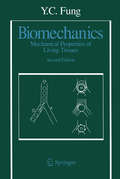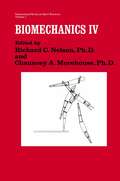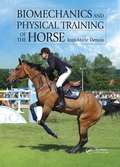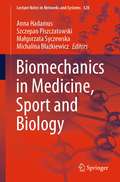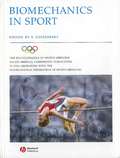- Table View
- List View
Biomechanics: Mechanical Properties of Living Tissues
by Y. C. FungThe objective of this book remains the same as that stated in the first edition: to present a comprehensive perspective of biomechanics from the stand point of bioengineering, physiology, and medical science, and to develop mechanics through a sequence of problems and examples. My three-volume set of Bio mechanics has been completed. They are entitled: Biomechanics: Mechanical Properties of Living Tissues; Biodynamics: Circulation; and Biomechanics: Motion, Flow, Stress, and Growth; and this is the first volume. The mechanics prerequisite for all three volumes remains at the level of my book A First Course in Continuum Mechanics (3rd edition, Prentice-Hall, Inc. , 1993). In the decade of the 1980s the field of Biomechanics expanded tremen dously. New advances have been made in all fronts. Those that affect the basic understanding of the mechanical properties of living tissues are described in detail in this revision. The references are brought up to date.
Biomechanics: Circulation
by Y.C. FungThe theory of blood circulation is the oldest and most advanced branch of biomechanics, with roots extending back to Huangti and Aristotle, and with contributions from Galileo, Santori, Descartes, Borelli, Harvey, Euler, Hales, Poiseuille, Helmholtz, and many others. It represents a major part of humanity's concept of itself. This book presents selected topics of this great body of ideas from a historical perspective, binding important experiments together with mathematical threads. The objectives and scope of this book remain the same as in the first edition: to present a treatment of circulatory biomechanics from the stand points of engineering, physiology, and medical science, and to develop the subject through a sequence of problems and examples. The name is changed from Biodynamics: Circulation to Biomechanics: Circulation to unify the book with its sister volumes, Biomechanics: Mechanical Properties of Living Tissues, and Biomechanics: Motion, Flow, Stress, and Growth. The major changes made in the new edition are the following: When the first edition went to press in 1984, the question of residual stress in the heart was raised for the first time, and the lung was the only organ analyzed on the basis of solid morphologic data and constitutive equations. The detailed analysis of blood flow in the lung had been done, but the physiological validation experiments had not yet been completed.
Biomechanics: Functional Adaption and Remodeling
by Kozaburo Hayashi Akira Kamiya Keiro Ono"Function dictates structure" is a classic paradigm reaffirmed in Wolff's law of the skeletal system. A major question being addressed by current research in biomechanics is whether this doctrine also holds true for the cardiovascular system and connective tissues. Taking a multidisciplinary approach to this question has produced new insights into the sensors, signals, and activators that produce remodeling and functional adaptation in cardiac muscle, blood vessels, and bone, including important new findings on the response of vascular endothelial cells to shear stress. Other work focuses on the extent of remodeling and adaptation processes in tendons, ligaments, and intervertebral discs. Together with two companion volumes, Computational Biomechanics and the Data Book on Mechanical Properties of Living Cells, Tissues, and Organs, this monograph will prove invaluable to those working in fields ranging from medical science and clinical medicine to biomedical engineering and applied mechanics.
Biomechanics: Selected Proceedings of the 3rd General Meeting of the European Society of Biomechanics Nijmegen, The Netherlands, 21–23 January 1982 (Developments in Biomechanics #1)
by H. W. Huiskes Dick H. Van Campen Joost R. De WijnBiomechanics as a scientific activity is not new. Already involved (or so it is said) in its practice were Aristotle (384-327 BC) and Leonardo da Vinci (1452-1519). Recently, however, it has become fashionable as a separate field, as witnessed by the existence of a Journal of Biomechanics (1968), an Interna tional (1973), a European (1976) and an American (1977) Society of Biomechanics, and an amount of (usually recently erected) Biomechanics Laboratories at Uni versities or other institutions throughout the world. If one or~anises a Con ference on Biomechanics, a relatively large number of scientists leave their cubicles or workshops to visit the place of worship. It becomes quickly evident, however, that such a forum for scientific communication is far from being homo geneous. All are not of the same believe, and the variety in professional inte rests almost parallels the number of attendants. "Biomechanics, the science of applying methods and principles of Mechanics to biological tissues and medical problems" is a definition which, in one form or another, has found wide acceptance among biomecanicians. Nevertheless, Bio mechanics is interwoven and thus often confused with other scientific endeavors. It is colored differently by its many fields of application (e. g. Orthopaedic and Cardio-Vascular Surgery, Dentistry, Rehabilitation, Physical Medicine, Injury Prevention, Sports and others), and the backgrounds of its disciplina ries. It partly overlaps sciences as Biomaterials, Medical Physics and Biophy sics, Physiology, and Functional Anatomy.
Biomechanics: Selected proceedings of the Fourth Meeting of the European Society of Biomechanics in collaboration with the European Society of Biomaterials, September 24–26, 1984, Davos, Switzerland (Developments in Biomechanics #2)
by S. M. Perren E. SchneiderThe papers presented at the Fourth 'Meeting of the European Society of Biomechanics, held in collaboration with the European Society for Biomaterials in late September 1984 in Davos, Switzerland, are published herewith. The main idea of the meeting was to gather together the many disciplines of researchers and clinicians active and interested in promoting biomechanical knowledge in one interdisciplinary society: the European Society of Biomechanics. We feel that the dialog across the disciplines is one of the important goals of the society, a goal which can be furthered by meetings like the one in Davos. A surgeon, whether a general, trauma or orthopaedic surgeon, is normally brought up without relevant exposure to spe cific technical problems. It therefore is not surprising that he speaks a different language with respect to mechanical problems than an engineer. Although a surgeon often has a feeling for what the solution to a particular problem might be, a fruitful inter disciplinary collaboration is made difficult by this scientific language barrier. On the other hand, a physicist, chemist, engi neer and metallurgist, to name a few, would do well with a realistic perception of the possibilities and limitations of surgery and of the relevance of a solution found to the initial question. Similar problems exist in other areas, e. g. in the field of sports biomechanics in the dialogue betweeen coach and researcher. Interdisciplinary misunderstandings have led to quite some unaeces£ary frustration in the past.
Biomechanics: Principles and Practices
by Donald R. Peterson Joseph D. BronzinoPresents Current Principles and ApplicationsBiomedical engineering is considered to be the most expansive of all the engineering sciences. Its function involves the direct combination of core engineering sciences as well as knowledge of nonengineering disciplines such as biology and medicine. Drawing on material from the biomechanics section of The
Biomechanics: Principles and Applications, Second Edition
by Donald R. Peterson Joseph D. BronzinoTraditionally, applications of biomechanics will model system-level aspects of the human body. As a result, the majority of technological progress to date appears in system-level device development. More recently, biomechanical initiatives are investigating biological sub-systems such as tissues, cells, and molecules. Fueled by advances in experime
Biomechanics and Biomaterials in Orthopedics
by Dominique G. PoitoutWith the constant evolution of implant technology, and improvement in the production of allograft and bone substitutes, the armamentarium of the orthopaedic surgeon has significantly expanded. In particular, the recent involvement of nanotechnologies opens up the possibilities of new approaches in the interactive interfaces of implants. With many important developments occurring since the first edition of this well-received book, this updated resource informs orthopaedic practitioners on a wide range of biomechanical advances in one complete reference guide.Biomechanics and Biomaterials in Orthopedics, 2nd edition compiles the most prominent work in the discipline to offer newly-qualified orthopedic surgeons a summary of the fundamental skills that they will need to apply in their day-to-day work, while also updating the knowledge of experienced surgeons. This book covers both basic concepts concerning biomaterials and biomechanics as well as their clinical application and the experience from everyday practical use. This book will be of great value to specialists in orthopedics and traumatology, while also providing an important basis for graduate and postgraduate learning.
Biomechanics and Biomaterials in Orthopedics
by Dominique G. PoitoutCurrent clinical orthopedic practice requires practitioners to have extensive knowledge of a wide range of disciplines from molecular biology to bioengineering and from the application of new methods to the evaluation of outcome. The biomechanics of and biomaterials used in orthopedics have become increasingly important as the possibilities have increased to treat patients with foreign material introduced both as optimized osteosynthesis after trauma and as arthroplasties for joint diseases, sequelae of trauma or for tumor treatment. Furthermore, biomaterial substitutes are constantly being developed to replace missing tissue. Biomechanics and Biomaterials in Orthopedics provides an important update within this highly important field. Professor Dominique Poitout has collected a series of high-quality chapters by globally renowned researchers and clinicians. Under the auspices of the International Society of Orthopaedic Surgery and Traumatology (SICOT) and International Society of Orthopaedic and Traumatology Research (SIROT), this book now provides permanent and specific access to the considerable international knowledge in the field of locomotor system trauma and disease treatment using the novel bioengineering solutions. This book covers both basic concepts concerning biomaterials and biomechanics as well as their clinical application and the experience from everyday practical use. This book will be of great value to specialists in orthopedics and traumatology, while also provide an important basis for graduate and postgraduate learning.
Biomechanics and Exercise Physiology: Quantitative Modeling
by Arthur T. JohnsonWhether you are a bioengineer designing prosthetics, an aerospace scientist involved in life support, a kinesiologist training athletes, or an occupational physician prescribing an exercise regimen, you need the latest edition of Biomechanics and Exercise Physiology: Quantitative Modeling. Using numerous worked examples to demonstrate what and when
Biomechanics and Mechanobiology of Aneurysms (Studies in Mechanobiology, Tissue Engineering and Biomaterials #7)
by Tim McGloughlinCardiovascular disease is the leading cause of morbidity and premature death of modern era medicine. It is estimated that approximately 81 million people in the United States (US) currently have one or more of the many forms of cardiovascular disease, resulting in 1 in every 2.8 deaths, or 900,000 deaths per year. 40% of all deaths in Europe are a result of cardiovascular disease in people under the age of 75. Aneurysms form a significant portion of these cardiovascular related deaths and are defined as a permanent and irreversible localised dilation of a blood vessel greater than 50% of its normal diameter. Although aneurysms can form in any blood vessel, the more lethal aneurysms develop in the cranial arteries, and in the thoracic aorta and abdominal aorta. Frequently aneurysms are undetected and if left untreated may eventually expand until rupture with very high levels of morbidity and mortality. The biomechanics and mechanobiology of aneursymal diseases are not fully understood and this monograph aims to provide new insights into aneurysm aetiology and behavior based on the most recent biomechanics research related to this important topic. The contributors to this volume bring together a unique blend of expertise in experimental, computational and tissue biomechanics relating to aneurysm behavior and enable the reader to gain a fresh understanding of key factors influencing aneurysm behavior and treatment. Biological risk factors such as tobacco smoking, sex, age, hypertension, family history and mechanobiological risk factors such as aneurysm geometry and shape as well as mechanical properties of the diseased tissues are considered in detail as are many of the diagnostic and treatment options.
Biomechanics and Physical Training of the Horse
by Jean-Marie DenoixEffective horse trainers strive to improve the performance of their horses while preserving the integrity of the musculoskeletal apparatus. Biomechanics and Physical Training of the Horse supplies an anatomical and functional overview of the topic, enabling trainers to optimize the different exercises their horses undergo during training and compet
Biomechanics and Sports: Proceedings of the XI Winter Universiads 2003 (CISM International Centre for Mechanical Sciences #473)
by Paolo B. PascoloOn XXI Winter Universiads 2003, CISM offered its scientific contribution by hosting a conference on mechanics applied to sports and, in general, to human movement. The conference was conceived as a chance to overview experiences gained from several operators working on different aspects of biomechanics. The reader will face in these proceedings bioengineering aspects, control issues, techniques for the optimization of human performances as well as methods for the improvement of athletic equipments and devices. Biomechanical data and signal processing, biomaterials and robotics complete the proposed framework. Some works were consistent with the fact that 2003 was designated as European Year of Disabled People. Indeed, many innovations in sport and biomechanics could suggest interesting rehabilitative applications and a better prevention of some pathologies due to the exercise of some normal activities like professional cycling. Ž
Biomechanics for Instructors
by Nikolai Aleksandrovich BernsteinThis book comprises a series of lectures given by celebrated Soviet neurophysiologist Nikolai Alexandrovich Bernstein in Moscow in 1925 and first published in Russian in 1926. Bernstein’s groundbreaking work, which has had a significant influence on the development of neuroscience, movement studies, and other fields of study in Russia, Eastern Europe, and the West, was suppressed during Stalin’s regime. At the time of its publication, Biomechanics for Instructors was a significant resource for teachers, with its descriptions of the movement of joints and degrees of freedom, illustrations of how to calculate the work capacity of muscles with bones acting as levers, the role of the central nervous system in movement, and more. Though the terminologies and methods have changed and been updated as research and technologies have progressed, the book remains a valuable introduction for those interested in Bernstein’s work more generally, and to those involved in the study of biomechanics. This book is also of interest to historians and philosophers of neuroscience, as well as those involved in movement studies in both the scientific and artistic domains, and to physiotherapists and those involved in sports research and practice.
Biomechanics for Life: Introduction to Sanomechanics
by Mark R. PitkinThe reader will find in this book a new approach to improving health. The author has called this approach “sanomechanics,” combining the Latin sanus (healthy, sound) and mechanicus (science of the motion of bodies subjected to forces). The focus of sanomechanics is on exercising with an understanding of the biomechanical consequences of the actions. This understanding is based on the author’s theory of the floating skeleton, which postulates a hydraulic connection of synovial joints. The theory explains the greater or lesser success of any exercise utilizing the ability of the human skeleton to absorb and transform forces and moments from the body segments and the environment. This ability vanishes with age and illnesses, and the deeper our understanding of the nature of skeletal functioning is, the better we shall be able to improve, protect, and prolong the skeleton’s health.
Biomechanics in Dentistry: Evaluation of Different Surgical Approaches to Treat Atrophic Maxilla Patients (SpringerBriefs in Applied Sciences and Technology)
by Muhammad Ikman Ishak Mohammed Rafiq Abdul KadirThis book shows computational finite element simulations to analyse the strength of implant anchorage for intrasinus and extramaxillary approaches under various occlusal loading locations and directions. Three-dimensional model of the craniofacial area surrounding the region of interest, soft tissue and framework are developed using computed tomography image datasets. The zygomatic and standard dental implants are modeled using a conventional computer-aided design software and placed at the appropriate location. Material properties are assigned appropriately for the cortical, cancellous bones and implants with Masseter forces applied at the zygomatic arch and occlusal loadings applied on the framework surface.
Biomechanics in Medicine, Sport and Biology (Lecture Notes in Networks and Systems #328)
by Anna Hadamus Szczepan Piszczatowski Małgorzata Syczewska Michalina BłażkiewiczThis book contains fourteen chapters dealing with various aspects of the biomechanics of today. The topics covered are glimpses of what modern biomechanics can offer scientists, students, and the general public. We hope this book can be inspiring, helpful, and interesting for many readers who are not necessarily concerned with biomechanics daily.
Biomechanics in Oncology (Advances in Experimental Medicine and Biology #1092)
by Cheng Dong Nastaran Zahir Konstantinos KonstantopoulosThis book covers multi-scale biomechanics for oncology, ranging from cells and tissues to whole organ. Topics covered include, but not limited to, biomaterials in mechano-oncology, non-invasive imaging techniques, mechanical models of cell migration, cancer cell mechanics, and platelet-based drug delivery for cancer applications. This is an ideal book for graduate students, biomedical engineers, and researchers in the field of mechanobiology and oncology.This book also:Describes how mechanical properties of cancer cells, the extracellular matrix, tumor microenvironment and immuno-editing, and fluid flow dynamics contribute to tumor progression and the metastatic processProvides the latest research on non-invasive imaging, including traction force microscopy and brillouin confocal microscopyIncludes insight into NCIs’ role in supporting biomechanics in oncology researchDetails how biomaterials in mechano-oncology can be used as a means to tune materials to study cancer
Biomechanics in Orthopedics
by Shigeo Niwa, Stephan M. Perren and Tomokazu HattoriA major part of orthopedics is the treatment of musculoskeletal diseases caused by structural disorders and mechanical breakdown of living tissue. Therefore, biomechanical consideration of static structures and dynamic mechanisms is compulsory for both diagnosis and treatment of orthopedic diseases. Previous biomechanical studies have enabled great advances in orthopedic implant technology, such as artificial joint replacement and instrumentation for spinal fusion. Consequently the importance of biomechanics is increasing more and more in daily clinical practice and development. In addition, biomaterial research into mechanical properties and tissue reactions of implant materials is certainly an important area of related study. This book is comprised of 22 papers presented at the International Seminar on Biomechanics in Orthopedics and the 17th Annual Meeting of the Japanese Society for Orthopedic Biomechanics, held in Nagoya in 1990. The volume contains full descriptions of both conventional and updated knowledge of the spine, ligaments, artificial joint replacement in the hip and knee, fracture treatment, and gait analysis, as well as biomaterials. I earnestly hope that this book will be of benefit to readers in daily clinical work and research. To close, I would like to thank profoundly the two coeditors, Prof. S.M. Perren and Mr. T. Hattori, and also a quiet supporter Mrs. J. Buchanan in Davos, for their cooperation in producing this book.
Biomechanics in Sport: Performance Enhancement and Injury Prevention (The Encyclopaedia of Sports Medicine #9)
by Vladimir ZatsiorskyBiomechanics in Sport is a unique reference text prepared by the leading world experts in sport biomechanics. Over thirty chapters cover a broad spectrum of topics, ranging from muscle mechanics to injury prevention, and from aerial movement to wheelchair sport. The biomechanics of sports including running, skating, skiing, swimming, jumping in athletics, figure skating, ski jumping, diving, javelin and hammer throwing, shot putting, and striking movements are all explained.
Biomechanics, Muscle Fibers, and How to Interface Experimental Apparatus to a Computer
by Masataka KawaiThis book is written to help and enable students in how to observe biological specimens in terms of viscosity, mass, elasticity and work producing elements. The observations are related to underlying chemical reactions by means of strain (fractional length change) sensitivity of the reactions, and a theory is developed how to connect these. Their mathematical derivation is complex when three or more states are involved, but a method is presented here to demonstrate how to simplify this complex problem. Basic mathematical solutions that are useful for this book, are presented (Fourier and Laplace transforms, differential equations, matrix operations) together with Fortran programs in the Appendix.
Biomechanics of Active Movement and Deformation of Cells (Nato ASI Subseries H: #42)
by Nuri AkkasCytomechanics is the application of the classical principles of mechanics in cell biology. It is an applied science concerned with the description and evaluation of mechanical properties of cells and their organelles as well as of the forces exerted by them. Thus, this topic needs a truly interdisciplinary approach, and accordingly this volume gives an up-to-date account of the current research done on cell division, mitosis, cytokinesis, cell locomotion and cell deformation during normal development and the cytoskeletal role in cell shape. Biologists, biomechanicians, biophysicists, biochemists and biomathematicians here discuss the basic concepts of mechanics and thermodynamics, emphasizing their applicability to cell activities.
Biomechanics of Active Movement and Division of Cells (Nato ASI Subseries H: #84)
by Nuri AkkasThe NATO Advanced Study Institute on Biomechanics of Active Movement and Division of Cells was held September 19-29, 1993 in Istanbul and the Proceedings are presented in this volume. Sixty-eight scientists from sixteen countries attended. Prof. J. Bereiter-Hahn of Goethe-Universitat, Frankfurt, Germany, Prof. A.K. Harris of the University of North Carolina, Chapel Hill, USA, Prof. R.M. Nerem of Georgia Institute of Technology, Atlanta, USA and Prof. R. Skalak of the University of California, San Diego, USA were the members of the International Organizing Committee. As the Scientific Director of the Institute, I wish to express my sincere appreciation for their assistance without which the Institute could not have taken place. This Institute is the third one of the meetings which are now called "the NATO Istanbul Meetings on Cytomechanics". The first one was the NATO Advanced Research Workshop on Biomechanics of Cell Division which was held October 12-17, 1986 in Istanbul. The Proceedings were published as NATO ASI Series A Life Sciences Vol. 132 by Plenum Press in 1987. The second one was the NATO Advanced Study Institute on Biomechanics of Active Movement and Deformation of Cells which was held September 3-13, 1989 in Istanbul. The Proceedings were published as NATO ASI Series H : Cell Biology Vol. 42 by Springer-Verlag in 1990.
Biomechanics of Cell Division (Nato Science Series A: #132)
by Nuri AkkasThere are virtually hundreds of life scientists publishing hundreds of papers a year on numerous aspects of the cell cycle. The following are few of the topics covered: cell membrane organization, membrane components, cytoskeleton and associated proteins, cell motility, actin in dividing cells, surface modulating assemblies, microfilaments, microtubules, cleavage furrow, fusion, etc. In all these topics, lifescientists talk about, among others, the forces within the system, the motion within the system and the failure of the system. The concepts of force, motion and failure are, one way or another, all related to the structure of the cell and to the mechanics of the cell activities. When the concepts of mechanics and structure enter the problem then one has to talk about biomechanics; in this case, biomechanics of cytology which we would like to call "Cytbmechanics". However, a review of the journals, books and conference proceedings related to various aspects of cytology reveals that mechanicians have not yet entered the field of cytology at a noticeable level. Some lifescientists have indeed made use of the general principles of mechanics in their works; however, no truly interdisciplinary publication has yet appeared from the collaboration of mechanicians and lifescientists in the field of, for instance, cell division.
